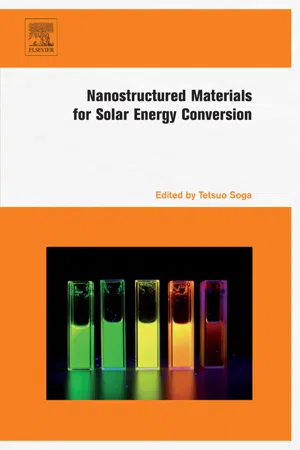
- 614 pages
- English
- ePUB (mobile friendly)
- Available on iOS & Android
Nanostructured Materials for Solar Energy Conversion
About This Book
Nanostructured Materials for Solar Energy Conversion covers a wide variety of materials and device types from inorganic materials to organic materials. This book deals with basic semiconductor physics, modelling of nanostructured solar cell, nanostructure of conventional solar cells such as silicon, CIS and CdTe, dye-sensitized solar cell, organic solar cell, photosynthetic materials, fullerene, extremely thin absorber (ETA) solar cell, quantum structured solar cell, intermediate band solar cell, carbon nanotube, etc. including basic principle and the latest results. There are many books written on conventional p-n junction solar cells, but few books focus on new concepts in this area.* Focuses on the use of nanostructured materials for solar energy* Looks at a wide variety of materials and device types* Covers both organic and inorganic materials
Frequently asked questions
Information
Fundamentals of Solar Cell
Publisher Summary
1. INTRODUCTION
2. FUNDAMENTAL PROPERTIES OF SEMICONDUCTORS [1–5]
2.1. Energy Band and Carrier Concentration
Table of contents
- Cover image
- Title page
- Table of Contents
- Preface
- Introduction
- Part I: Fundamentals of Nanostructured Solar Cells
- Part II: Nanostructures in Conventional Thin Film Solar Cells
- Part III: Dye-Sensitized Solar Cells
- Part IV: Organic- and Carbon-Based Solar Cells
- Part V: Other Nanostructures
- Index